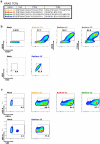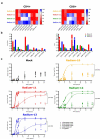Targeting KRAS mutations with HLA class II-restricted TCRs for the treatment of solid tumors
- PMID: 34235003
- PMCID: PMC8216182
- DOI: 10.1080/2162402X.2021.1936757
Targeting KRAS mutations with HLA class II-restricted TCRs for the treatment of solid tumors
Abstract
T-cell receptor (TCR) redirected T cells are considered as the next generation of care for the treatment of numerous solid tumors. KRAS mutations are driver neoantigens that are expressed in over 25% of all cancers and are thus regarded as ideal targets for Adoptive Cell Therapy (ACT). We have isolated four KRAS-specific TCRs from a long-term surviving pancreatic cancer patient vaccinated with a mix of mutated KRAS peptides. The sequence of these TCRs could be identified and expressed in primary cells. We demonstrated stable expression of all TCRs as well as target-specific functionality when expressing T cells were co-incubated with target cells presenting KRAS peptides. In addition, these TCRs were all partially co-receptor independent since they were functional in both CD4 and CD8 T cells, thus indicating high affinity. Interestingly, we observed that certain TCRs were able to recognize several KRAS mutations in complex with their cognate Human leukocyte antigen (HLA), suggesting that, here, the point mutations were less important for the HLA binding and TCR recognition, whereas others were single-mutation restricted. Finally, we demonstrated that these peptides were indeed processed and presented, since HLA-matched antigen presenting cells exogenously loaded with KRAS proteins were recognized by TCR-transduced T cells. Taken together, our data demonstrate that KRAS mutations are immunogenic for CD4 T cells and are interesting targets for TCR-based cancer immunotherapy.
Keywords: Adoptive Cell Therapy; Immunotherapy; KRAS; TCR.
© 2021 The Author(s). Published with license by Taylor & Francis Group, LLC.
Figures




Similar articles
-
Targeting KRASG12V mutations with HLA class II-restricted TCR for the immunotherapy in solid tumors.Front Immunol. 2023 May 23;14:1161538. doi: 10.3389/fimmu.2023.1161538. eCollection 2023. Front Immunol. 2023. PMID: 37287989 Free PMC article.
-
Therapeutic potential of T-cell receptor targeting the HLA-A*11:01-restricted KRASG12V neoantigen without cross-recognition of the self-antigen RAB7B in solid tumors.J Immunother Cancer. 2025 Jul 18;13(7):e011863. doi: 10.1136/jitc-2025-011863. J Immunother Cancer. 2025. PMID: 40681176 Free PMC article.
-
High-affinity oligoclonal TCRs define effective adoptive T cell therapy targeting mutant KRAS-G12D.Proc Natl Acad Sci U S A. 2020 Jun 9;117(23):12826-12835. doi: 10.1073/pnas.1921964117. Epub 2020 May 27. Proc Natl Acad Sci U S A. 2020. PMID: 32461371 Free PMC article.
-
Structural basis for T cell recognition of cancer neoantigens and implications for predicting neoepitope immunogenicity.Front Immunol. 2023 Nov 17;14:1303304. doi: 10.3389/fimmu.2023.1303304. eCollection 2023. Front Immunol. 2023. PMID: 38045695 Free PMC article. Review.
-
Needle in a Haystack: The Naïve Repertoire as a Source of T Cell Receptors for Adoptive Therapy with Engineered T Cells.Int J Mol Sci. 2020 Nov 6;21(21):8324. doi: 10.3390/ijms21218324. Int J Mol Sci. 2020. PMID: 33171940 Free PMC article. Review.
Cited by
-
Facts and Hopes in Immunotherapy Strategies Targeting Antigens Derived from KRAS Mutations.Clin Cancer Res. 2024 May 15;30(10):2017-2024. doi: 10.1158/1078-0432.CCR-23-1212. Clin Cancer Res. 2024. PMID: 38266167 Free PMC article. Review.
-
Barcoding intracellular reverse transcription enables high-throughput phenotype-coupled T cell receptor analyses.Cell Rep Methods. 2023 Oct 23;3(10):100600. doi: 10.1016/j.crmeth.2023.100600. Epub 2023 Sep 29. Cell Rep Methods. 2023. PMID: 37776855 Free PMC article.
-
Sarcoma Common MHC-I Haplotype Restricts Tumor-Specific CD8+ T Cell Response.Cancers (Basel). 2022 Jul 14;14(14):3414. doi: 10.3390/cancers14143414. Cancers (Basel). 2022. PMID: 35884474 Free PMC article.
-
An Engineered Soluble Single-Chain TCR Engager for KRAS-G12V Specific Tumor Immunotherapy.Adv Sci (Weinh). 2025 Aug;12(31):e00181. doi: 10.1002/advs.202500181. Epub 2025 Jun 5. Adv Sci (Weinh). 2025. PMID: 40470869 Free PMC article.
-
Identification and validation of a T cell receptor targeting KRAS G12V in HLA-A*11:01 pancreatic cancer patients.JCI Insight. 2025 Jan 23;10(2):e181873. doi: 10.1172/jci.insight.181873. JCI Insight. 2025. PMID: 39846249 Free PMC article.
References
-
- Lee DW, Kochenderfer JN, Stetler-Stevenson M, Cui YK, Delbrook C, Feldman SA, Fry TJ, Orentas R, Sabatino M, Shah NN, et al. T cells expressing CD19 chimeric antigen receptors for acute lymphoblastic leukaemia in children and young adults: a phase 1 dose-escalation trial. Lancet. 2015;385(9967):517–528. doi:10.1016/S0140-6736(14)61403-3. - DOI - PMC - PubMed
Publication types
MeSH terms
Substances
LinkOut - more resources
Full Text Sources
Medical
Molecular Biology Databases
Research Materials
Miscellaneous
